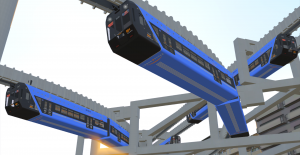
DOWNLOAD
All the necessary dependencies are included in this .rar or avaible on the DLS.
The 0 Series was introduced in 2012 by Chiba Urban Monorail as a replacement for the older 1000 Series trains that the company had been using since the opening of the first section of the system in 1988.
Depsite being just around 20 years old, by the second-half of the 2000s, plans were already in motion to replace the original trains of the systems, as they had precociously aged, and were wearing down relatively fast due to the tortuous nature of the Chiba Urban Monorail system, with very tight curves and extremely steep slopes.
The first proposals to introduce a new train were made around 2006, and in 2007, the company provisionally settled on the “Urban Flyer 0” name. Original plans called for the new trains to be put in revenue service by 2009, but likely due to budgetary constraints, the first new trains arrived on Chiba Urban Monorail’s premises in 2012.
Manufactured by Mitsubishi Heavy Industries, the new trains were (or better, had to be) based on their predecessors, the 1000 Series also built by Mitsubishi (as the conglomerate is the only holder of the SAFEGE monorail design licenses, it is the only possible manufacturer), in particular regarding the overall shape, aluminum bodyshell, door placement, internal layout and bogies. However, accordingly modern equipment was fitted to these trains, namely an up-to-date IGBT-VVVF inverter (manufactured by Mitsubishi Electric and of the same type that was being produced en-masse for JR East’s then-new E233 Series trains), electrically-powered doors, LED destination boards and train number indicators and passenger information displays. Unlike the older trains, the new 0 Series was also designed to comply with the current norms regarding barrier-free access, something that the old 1000 Series trains weren’t (and still aren’t).
The exterior styling was contracted out to the renowned GK industrial design firm, wich created a strikingly modern black and light blue livery with white linings, a stark contrast with the dull unpainted aluminum livery of the older 1000 Series.
With the “0 Series” classification and the “Urban Flyer” nickname made official, the first of the new trains began a series of test along the Chiba Urban Monorail network , starting from static testing inside the system’s Dobutsukoen depot, beginning in Januray, and then moving onto daytime test runs thruought the whole system, starting in April. With the mandatory test runs completed, the first 0 Series set finally entered revenue service on the 8th of July 2012.
Plans originally called for a bulk order of 0 Series trains to replace all of the twenty older 1000 Series sets in the shortest possible time, however due to yet more budgetary constraints (economically speaking, Chiba Urban Monorail isn’t exactly doing well), the order had to be considerably curtailed, being limited to just three 0 Series sets for 2012, followed by one set more in 2014.
With four new trains available in service, gradual withdrawals of the oldest 1000 Series sets could began, with the very first batch (the 1988-built cars) being removed from service in 2015.
Two more 0 Series sets were delivered in 2019 (five years since the last delivery!) and were followed by two more in 2020, allowing Chiba Urban Monorail to retire the second-batch 1000 Series trains (wich had been built in 1991).
As of now, no new 0 Series trains have been delivered since, bringing the total to eight 0 Series sets in service as of today, currently amounting to exactly 50% of Chiba Urban Monorail’s fleet, as the remaining 1000 Series sets are also eight, built between 1993 and 1999.
Chiba Urban Monorail’s plans are to definitely retire the 1000 Series, but due to the already variously mentioned budgetary issues, this is expected to take quite a lot of time: official plans call for the introduction of atleast seven more sets, with the objective to replace the 1000 Series by 2028 at best!
Trivia #1
In 2012, the cost of each new 0 Series set was about 290 milion yen – 323 milion yen adjusted for inflation as of today, equivalent to 2,03 milion euro or 2,14 milion US dollars.
Trivia #2
GK Industrial Design’s work was reviewed by a dedicated committee, formed by acaemic experts and officials from Chiba Urban Monorail, and modified atleast four times.
Trivia #3
The design concept for the 0 Series was “sora” (“Sky” in Japanese), in theme with Chiba Urban Monorail’s “nature” of having trains gliding between buildings up into the sky.
Trivia #4
GK Industrial Design’s work on the 0 Series was awarded the 2012 “Good Design” award.
Trivia #5
The door chime of the 0 Series was developed jointly with Chiba University.
Trivia #6
By 2028, the year of the planned replacement of the 1000 Series, the oldest 0 Series sets will be 16 years old, almost as old as were the oldest 1000 Series sets when their replacement began to be considered!
A 16-year production timespan with limited modifications is also something basically unheard of in modern times, and can only be rivaled by the more or less equally long production timespans of some of JNR’s classic EMU, DMU and locomotive designs.
